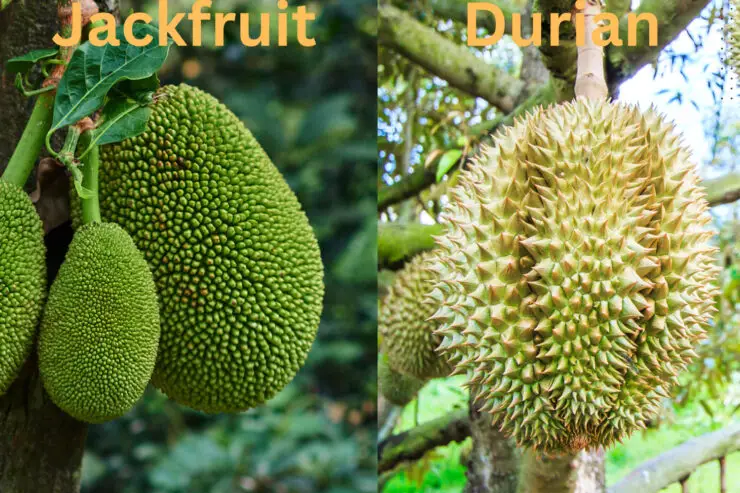As an Amazon Associate I earn from qualifying purchases. Please read the disclaimer for more info.
Imagine yourself in a bustling marketplace in Southeast Asia. The air is thick with the scent of exotic spices and ripe fruit. Two fruits stand out among the countless produce stands – the durian and jackfruit. Enormous, prickly, and emitting a unique aroma, these tropical marvels are not your everyday fruits. As we journey into the world of jackfruit vs durian, we’ll discover their origins, distinctive characteristics, and the sensory experiences they offer.
Ready for a tropical adventure? Let’s dive right in!
Jackfruit vs Durian: The Short Summary
- Jackfruit and durian have distinct origins, native regions, botanical families, appearances, and aromas.
- Jackfruit is chewy with a sweet taste, while durian has a creamy texture and a unique mix of flavors. Both are great for savory and sweet dishes!
- They offer health benefits but should be consumed in moderation due to potential risks like digestive issues or interactions with medications.
Origins and Classification
Native Regions
If we trace the roots of these two fruits, we find ourselves in Asia’s warm, fertile lands. The native regions of these fruits play a significant role in their development and characteristics.
Jackfruit, with its scientific name Artocarpus heterophyllus, hails from India, a country renowned for its rich biodiversity. This region’s humid, warm climate creates the perfect conditions for the jackfruit tree to thrive.
On the other hand, durian, known scientifically as Durio zibethinus, with its notorious smell and distinctive taste, is native to Malaysia, Indonesia, and Thailand. With their tropical, rainforest-like climates, these countries provide the perfect home for durian trees.
The conditions in these regions significantly influence these fruits’ growth, taste, and aroma.
Botanical Families
Despite their similar tropical origins, these two fruits belong to different botanical families. Jackfruit is a part of the Moraceae family, a group of flowering plants that includes figs and mulberries. This family is known for its diverse species that produce latex, a milky white fluid that is often visible when the fruit is cut or broken.
On the other hand, durian is a member of the Malvaceae family. This family includes plants like hibiscus and okra and is known for its unique seed dispersal methods, often involving animals or wind. Durian seeds, in particular, are dispersed in a similar manner.
These classifications reflect these two fascinating fruits’ unique characteristics and evolutionary adaptations.
Appearance and Aroma

The first things that strike you in the jackfruit vs durian comparison are their appearances and aromas.
Size and Color
When it comes to size and color, jackfruit and durian present quite a contrast.
The jackfruit, hailed as the largest fruit in the world, dwarfs the durian with its massive size. A single jackfruit can weigh up to 55 pounds and can reach up to 36 inches in length. Its green, knobby exterior hides a treasure trove of sweet, yellow flesh inside.
Although smaller, Durian, also known as durian fruit, is no less impressive. Weighing between 2 and 7 pounds, durians have a spiky exterior, which ranges from a green to a yellow-brown hue, often intimidating first-time tasters. But those brave enough to venture inside are rewarded with a unique culinary experience.
Texture
The texture of these fruits plays a significant role in their appeal and culinary uses.
With its fibrous and chewy texture, Jackfruit is often used as a meat substitute in vegetarian dishes. This texture and its sweet flavor make it a versatile ingredient in sweet and savory dishes.
When it comes to jackfruit versus durian, durian has a creamy and soft texture akin to custard. This unique texture and intense flavor make durian a favorite for desserts and sweet dishes in Southeast Asia.
Smell
If there is one major difference in the jackfruit vs durian comparison it’s the elephant in the room – the smell.
Jackfruit emits a sweet and fruity scent that many find pleasant. It’s a refreshing aroma that complements the fruit’s sweet flavor.
On the other hand, Durian is notorious for its strong, pungent smell. Some people love it, while others find it off-putting. This smell, often compared to smelly socks or rotten onions, has earned durian the title of ‘smelliest fruit in the world’. Despite this, durian lovers defend the fruit quickly, claiming that its taste more than makes up for the smell.
Yet, despite these differences, both fruits offer a sensory experience that is hard to forget.
Taste and Culinary Uses
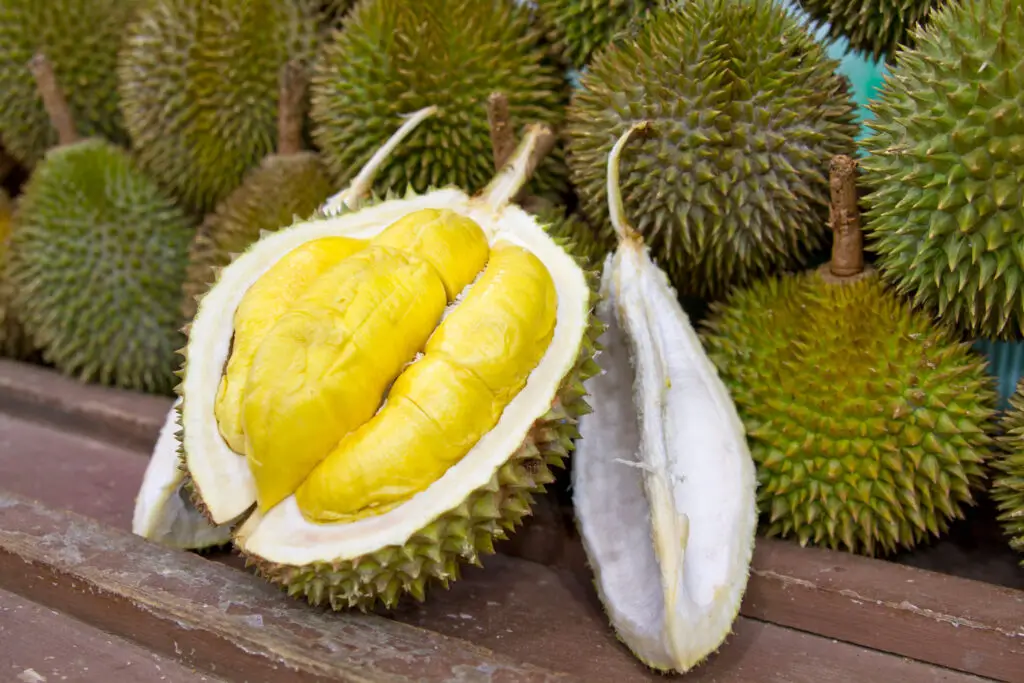
When it comes to taste and culinary uses, jackfruit, and durian each have their unique characteristics.
Unripe jackfruit has a meaty texture and is commonly used as a meat substitute in vegetarian dishes. With its sweet flavor, ripe jackfruit is perfect for desserts and sweet dishes. The seeds can be roasted or boiled and used as a snack, increasing its culinary versatility.
On the other hand, Durian presents a unique blend of sweet and savory flavors with a hint of saltiness. It’s a flavor profile that has earned it the title ‘King of Fruits’ in many Southeast Asian countries. Despite its notorious smell, durian is used in a variety of culinary applications, from sweet desserts and pastries to savory dishes like curries and soups.
Like jackfruit, durian is also used in the creation of a variety of processed foods, such as ice cream, cakes, and candies.
Flavors
Let’s dive into the flavors of our jackfruit vs durian comparison.
With its sweet taste, Jackfruit often reminds people of a mix of tropical flavors like apple, pineapple, mango, and banana. This fruit has versatility and an enticing flavor that makes jackfruit a favorite in various dishes. It can be used to create both sweet and savory dishes.
On the other hand, durian presents a unique mix of sweet and savory flavors with a hint of saltiness. Some people describe the flavor of durian as a mix of custard and almonds with a hint of garlic. Some even describe the as like sweet cheese.
These unique flavors make both fruits an exciting addition to a variety of dishes.
Textures
The textures of jackfruit and durian play a crucial role in their culinary applications.
Jackfruit has a fibrous and chewy texture, especially when it’s unripe. This texture and its sweet flavor make it a versatile ingredient in sweet and savory dishes.
On the other hand, Durian has a creamy and soft texture similar to custard. This unique texture and intense flavor make durian a favorite for desserts and sweet dishes in Southeast Asia.
Whether you’re looking for a chewy meat substitute or a creamy dessert ingredient, these fruits have got you covered.
Culinary Applications
The versatility of jackfruit and durian in the culinary world is quite impressive.
With its meat-like texture, when unripe, Jackfruit is a popular meat substitute in vegetarian dishes. It can be used in curries, stews, stir-fries, and even as a filling for sandwiches and wraps.
With its sweet flavor, ripe jackfruit is perfect for desserts and sweet dishes.
Despite its notorious smell, Durian is used in various culinary applications. It’s a popular ingredient in sweet desserts, pastries, and savory dishes like curries and soups. Its unique flavor and creamy texture make it a favorite in Southeast Asian cuisine.
Nutritional Comparison
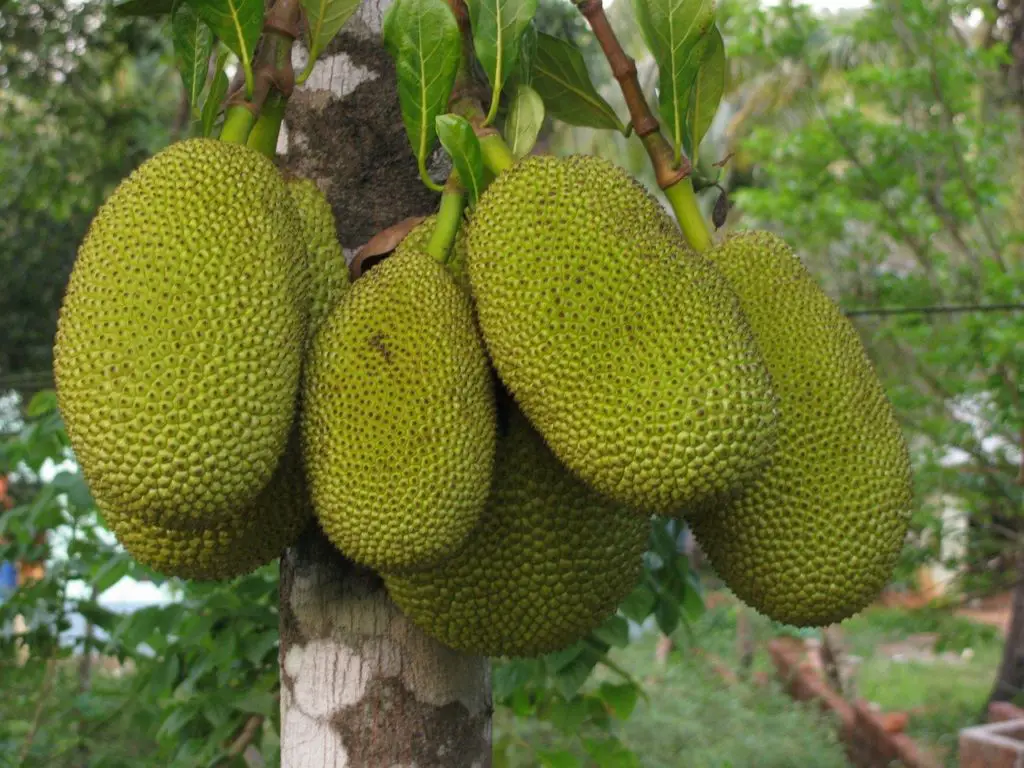
Not just the taste and texture make jackfruit and durian fascinating; their nutritional profiles are equally impressive. Both fruits are packed with essential nutrients that contribute to a healthy diet. However, the nutritional composition of jackfruit and durian varies, with each fruit offering unique health benefits.
Jackfruit is rich in dietary fiber, which aids digestion and promotes a sense of fullness, making it a great addition to weight loss diets. It is also a good source of vitamin C, which boosts the immune system, and vitamin A, which supports eye health.
On the other hand, durian is high in calories and fats, making it a high-energy fruit perfect for those needing an energy boost. It’s also an excellent source of dietary fiber, B vitamins, and vitamin C.
Despite their differences, both fruits offer a wealth of health benefits, making them a great addition to a balanced diet.
Macronutrients
Jackfruit and durian have quite different macronutrient profiles.
Durian is higher in calories, fat, and carbohydrates, making it a high-energy fruit that’s perfect for those needing an energy boost. It’s also a good source of dietary fiber, which aids in digestion and promotes a sense of fullness.
On the other hand, jackfruit is lower in calories and fat but higher in protein and fiber, making it a great option for those watching their calorie intake or looking for a meat substitute in vegetarian dishes.
Vitamins
In terms of vitamins, both jackfruit and durian are nutrient powerhouses.
Durian is particularly rich in B vitamins, including B1, B2, and B3, which are crucial for energy production and nervous system health.
On the other hand, jackfruit boasts higher amounts of vitamins A, E, B5, and B6. Vitamin A supports eye health, vitamin E acts as an antioxidant, and B vitamins are essential for various metabolic processes.
Regardless of the differences, both fruits provide a remarkable array of vitamins, contributing to their overall nutritional value.
Minerals
The mineral content of jackfruit and durian also varies.
Durian is a good source of copper, zinc, iron, and phosphorus, which play crucial roles in various bodily functions, including energy production, immune function, and bone health.
On the other hand, Jackfruit is richer in calcium, potassium, and vitamin C. Calcium is essential for bone health, potassium regulates fluid balance and nerve signals, and vitamin C supports immune function and skin health.
Thus, both fruits offer unique mineral compositions, adding to their nutritional appeal.
Health Benefits and Risks: Jackfruit vs Durian
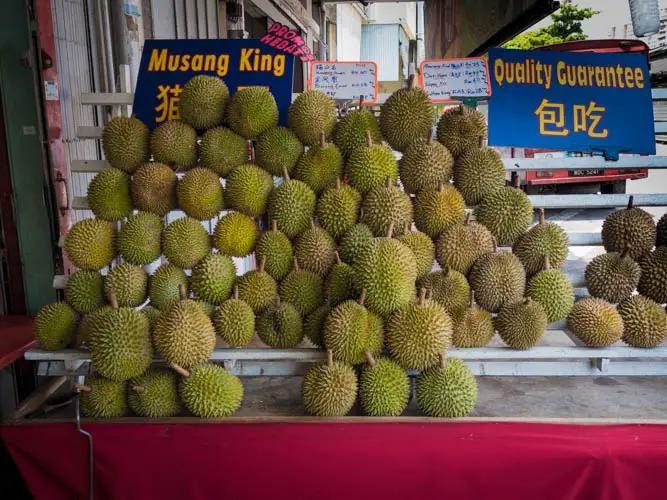
While jackfruit and durian are delightful for their unique flavors and textures, they also come with a host of health benefits.
Fruits are powerhouses of antioxidants. Phenolic compounds, flavonoids, carotenoids, and vitamin C are some examples found in abundance. These antioxidants help combat oxidative stress in the body, reducing the risk of chronic diseases such as heart disease and cancer. Moreover, both fruits possess antibacterial, anti-inflammatory, and anticancer properties thanks to their rich phytochemical content. Jackfruit, in particular, is known for its powerful anti-cancer qualities, effective against colorectal, hepatic, and leukemia.
However, as with all foods, moderation is key. Overeating jackfruit or durian can lead to digestive problems like bloating, gas, and diarrhea. Durian can also cause allergic reactions in some individuals. Potential risks are also associated with consuming these fruits, such as hypoglycemia and possible interactions with sedative medications.
Therefore, while these fruits offer a wealth of health benefits, they should be consumed in moderation and with caution in certain populations.
Health Benefits
The health benefits of jackfruit and durian are numerous. Both fruits are packed with potent antioxidants like phenolic compounds, flavonoids, carotenoids, and vitamin C, which help combat oxidative stress in the body, reducing the risk of chronic diseases such as heart disease and cancer.
Moreover, both fruits possess antibacterial, anti-inflammatory, and anticancer properties thanks to their rich phytochemical content. Jackfruit, in particular, is known for its powerful anti-cancer qualities, effective against colorectal, hepatic, and leukemia. The consumption of jackfruit seeds also contributes to the overall health benefits of this amazing fruit.
These health benefits make these fruits a great addition to a balanced diet.
Potential Risks
While the health benefits of jackfruit and durian are impressive, it’s important to be aware of some potential risks. Overeating these fruits can lead to digestive problems like bloating, gas, and diarrhea. In addition, cherries can cause allergic reactions in some individuals.
There are also potential risks, such as hypoglycemia and possible interactions with sedative medications. Durian has a high sugar content, which could lead to blood sugar spikes in individuals with diabetes.
Cultivation and Commercial Aspects
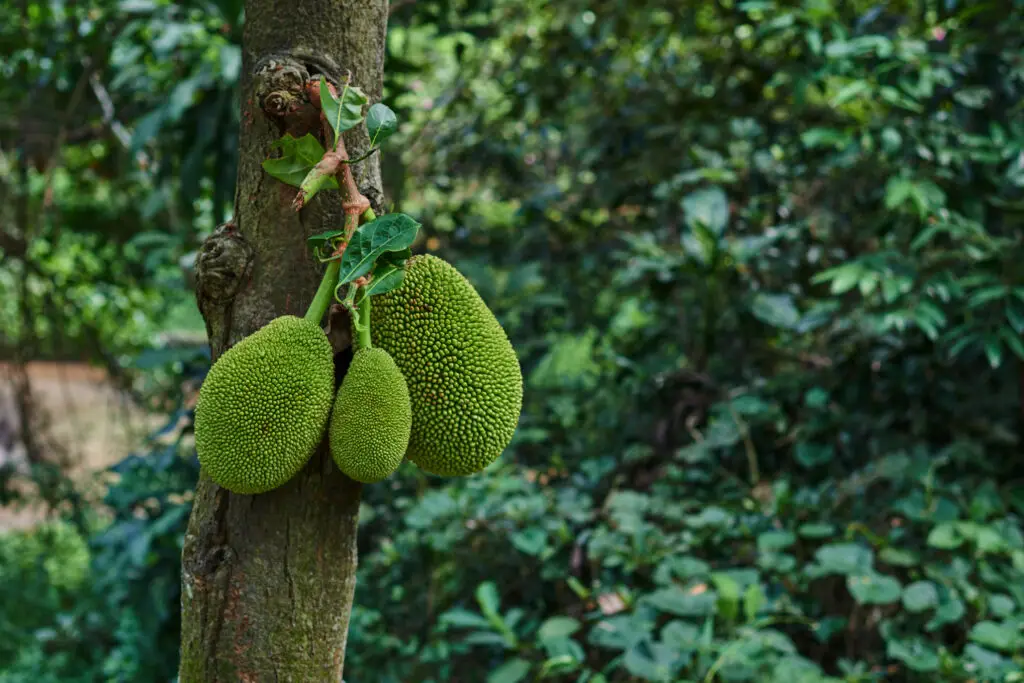
Jackfruit and durian cultivation and commercial aspects are as interesting as their sensory profiles. These fruits’ different growth habits and agricultural practices lead to their unique characteristics.
With a fast growth rate, jackfruit trees can reach up to 30 m high and 80-200 cm in diameter. They thrive in tropical climates and need lots of water and sun.
On the other hand, Durian trees can only be grown in certain regions like southeast Asia, where the climate is perfect for growing tropical fruits. They need a lot of water, sunlight, regular pruning, and fertilization.
In terms of commercial uses, jackfruit and durian are used in a variety of ways.
Jackfruit is popular in dishes like curries, salads, and desserts. It’s also used to make juices, jams, and other processed foods.
Despite its infamous smell, Durian is used in various culinary applications, including sweet desserts and pastries, as well as savory dishes like curries and soups. However, the durian’s distinctive smell has led to it being banned in certain markets and public transportation systems.
Growth Habits
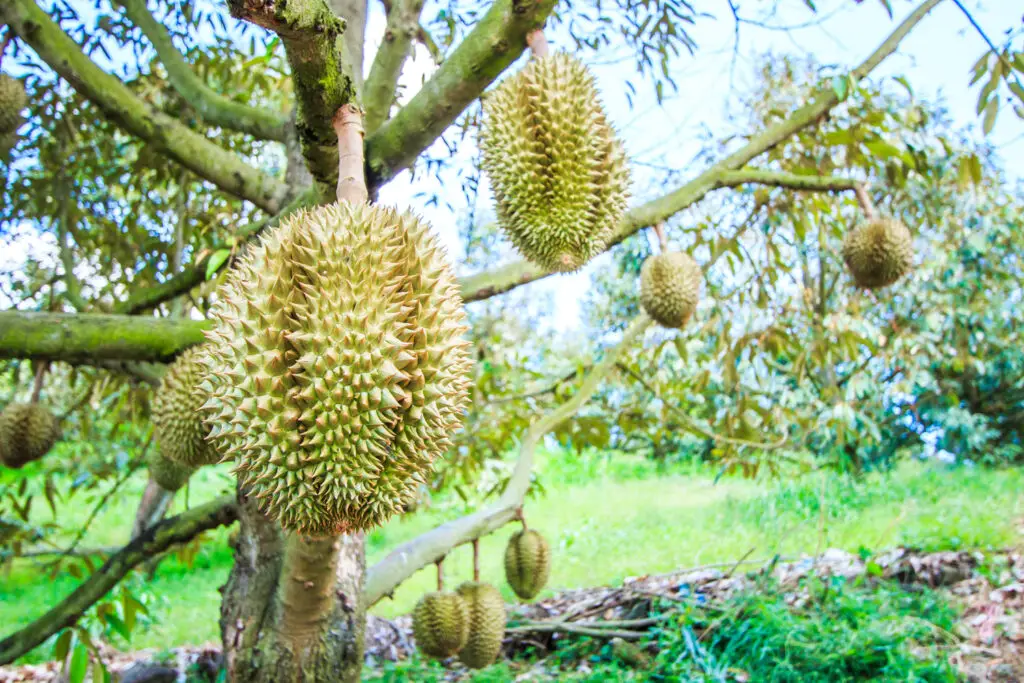
The growth habits of jackfruit and durian are influenced by their native regions.
Jackfruit, native to the humid lowlands of Southern India, prefers warm weather and thrives in temperatures between 75 to 86 degrees Fahrenheit. On the other hand, durian, native to the rainforests of Southeast Asia, requires deep, rich soil and cross-pollination for optimal growth.
These unique growth requirements contribute to the distinctive characteristics of these fruits, from their size and appearance to their flavor and aroma.
Agriculture

Agricultural practices for cultivating jackfruit and durian vary. Jackfruit is typically grown along roadsides in India, thriving in the country’s tropical climate. Regular pruning and fertilizing are essential to maintain the health of the jackfruit tree.
On the other hand, Durian is produced on small farms in places like Malaysia and Indonesia, where the climate is perfect for growing tropical fruits.
These distinct agricultural practices contribute to these two fruits’ unique characteristics and profiles.
Commercial Uses
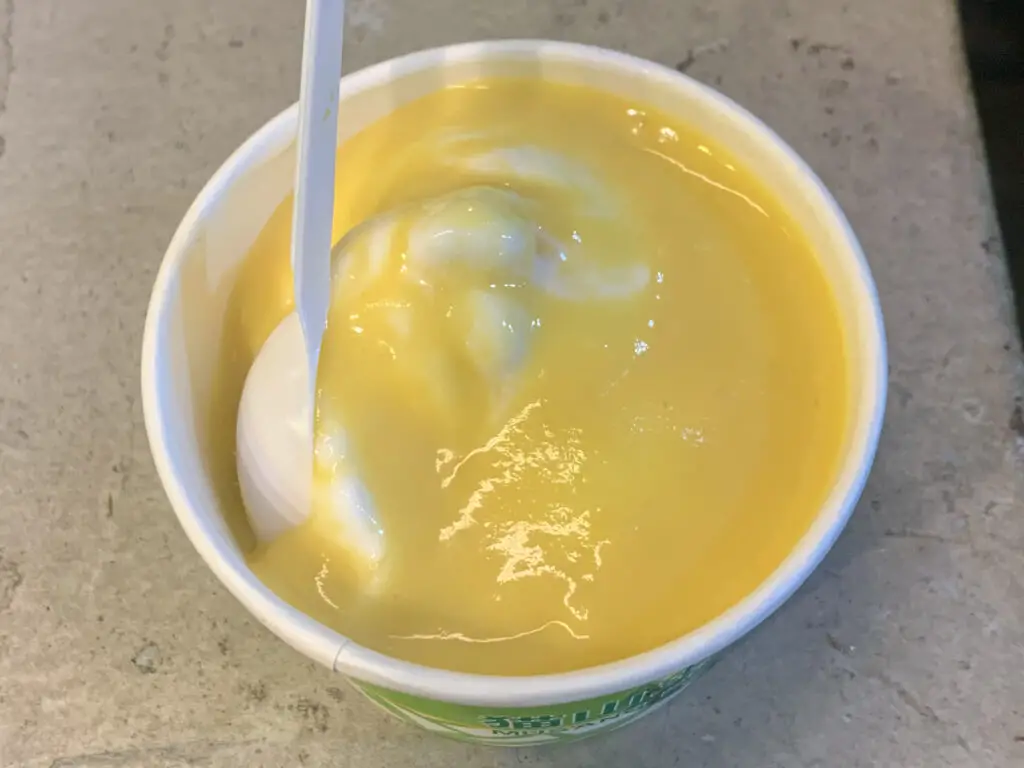
Commercially, jackfruit and durian find their way into a variety of products and dishes. Jackfruit is often used as a meat substitute in vegetarian dishes due to its fibrous texture when unripe. Its sweet flavor, when ripe, makes it a perfect addition to desserts and sweet dishes. Additionally, jackfruit is used to flavor products like ice cream and beverages and is used to make jams, chutneys, and candies.
Despite its notorious smell, Durian is used in various culinary applications, such as sweet desserts and pastries, as well as savory dishes like curries and soups.
Summary Jackfruit vs Durian
In our tropical adventure, we’ve explored the fascinating world of jackfruit and durian, two fruits that offer unique sensory experiences. From their origins in the fertile lands of Asia to their distinctive appearances, smells, and tastes, these fruits are a testament to nature’s diversity. Despite their differences, they share a common thread – both are packed with nutrients and offer numerous health benefits. So whether you’re drawn to the sweet, tropical flavor of jackfruit or the unique, intense flavor of durian, remember to savor the experience, one bite at a time. After all, life is too short for boring fruit!
Frequently Asked Questions
Why is durian fruit controversial?
Durian fruit is controversial due to its overwhelming smell, which has been known to cause evacuations of subways, schools, and hospitals. Because of this, it’s illegal to eat in public in many south-east Asian countries.
Is jackfruit an acquired taste?
Jackfruit has a sweet and tropical flavor when ripe, similar to banana, pineapple, and mango. However, its unripe form is starchy and less sweet, with a texture more similar to a vegetable. Some people describe its scent as reminiscent of jellybeans or bubblegum, while others liken it to the smell of rotten onions.
Overall, jackfruit is an acquired taste.

